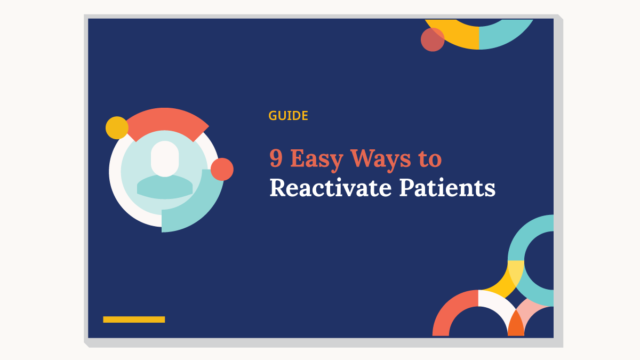Let’s be honest: calling patients to remind them about overdue appointments can feel a bit like being stuck on a merry-go-round. By the time your front office team has finished leaving voicemails, sending recall messages, and chasing down patients to schedule, another day has slipped by—and the list of overdue patients continues to grow.
But what if you could streamline that entire process? What if your staff didn’t have to spend valuable hours making routine calls? That’s the beauty of recall automation—it takes those manual tasks off your team’s plate so they can focus on higher-value activities that help your practice thrive. A 2022 Forbes report found that 80% of healthcare practices planned to adopt digital solutions such as automation over the next five years.
Next, we’ll explore how recall automation allows you to reduce manual reactivation activities and how that improves patient retention, practice operational efficiency, and adds up to a healthier bottom line.
Why is manual recall holding your healthcare practice back?
Let’s break down the manual patient recall system:
- Generating a list of patients due or overdue for routine care (6-mo. Or annual checkups, follow-ups, screenings, etc.).
- Calling each patient (often multiple times) to get them booked.
- Leaving voicemails, sending texts, or following up with emails if the patient doesn’t respond.
- Tracking missed calls to ensure nobody falls through the cracks.
Even with the most organized front desk team, manual recall alerts are time-consuming. Plus, staff members often juggle these calls alongside handling in-person check-ins, scheduling, and a hundred other front-office tasks. The result? Much time is spent on repetitive work instead of delivering a great patient experience.
What is automated patient recall and how can it significantly reduce manual tasks?
Automated recall tools handle much of the busy work involved in routine patient communication. Instead of calling each patient individually, the system automatically sends reminders via text, email, or even voicemail drops—whatever your patients prefer.
Customers of one leading provider of patient communication tools and were able to reduce their recall activities to 30 minutes or less per day with an automated recall tool.
Think about the impact of freeing up that kind of time. If your staff can save just one hour a day, that’s 20 hours per month—time they could spend assisting patients in the office, handling more complex queries, or improving other administrative processes that actually grow your practice while reducing administrative burden.
Where do we see the biggest time savings with recall automation?
Let’s say your practice has 500 patients who are due or overdue for an annual wellness exam:
- Manual approach: Each phone call takes roughly 5 minutes (to dial, wait for an answer, chat or leave a voicemail, then record notes). Even if you only manage to reach half of them, that’s still 1,250 minutes—or about 20 hours—spent every year on calls for just one appointment type.
- Automated recall: Most automated systems can send all your reminders in a few clicks. The time spent is drastically reduced to 4–5 hours annually (or even less) for the same outreach.
By letting automation do the heavy lifting, you’re saving staff hours each week and redirecting that time and energy to more pressing patient needs.
Why does automated recall improve patient satisfaction?
There’s a common misconception that automated communication is less personal. In reality, automated recalls can dramatically improve the patient experience:
- Convenient Communication: A 2021 HIMSS survey found that 7 in 10 patients prefer to get healthcare messages like recall notifications as text messages or emails rather than phone calls. They love the flexibility of responding at their own convenience and avoiding phone tag.
- Reduced Stress: Instead of missing a call and having to call back, patients receive a simple link or prompt to book or confirm online. No more waiting on hold or rushing to pick up a call at an inconvenient time.
- Better Clarity: Automated messages can include details like appointment prep instructions or directions, so patients know exactly what to expect.
- Personal Touch at Scale: Automated solutions often allow you to customize messages with the patient’s name, type of appointment, and targeted health reminders—keeping a human element while streamlining the process.
Happier patients tend to be more loyal to a practice. By making communication simpler and more transparent, you boost their satisfaction and keep them engaged with their health.
How does recall automation improve health outcomes?
Besides convenience, automation has a direct impact on patient health outcomes:
- Timely Care: With consistent reminders, patients don’t put off necessary check-ups, screenings, or wellness checks. This can lead to earlier detection of issues and better management of chronic conditions
- Higher Attendance: Clear, automated outreach translates to better attendance and fewer no-shows.
- Proactive Approach: Encouraging patients to stay on top of routine care can help catch health issues earlier and improve overall well-being.
It’s a win-win: patients appreciate the convenience, and your practice sees higher follow-up appointment attendance rates, leading to better health outcomes.
How can automated recall grow your revenue?
Beyond the time savings and patient satisfaction, automated recall can have a real impact on your practice’s bottom line by:
- Filling More Appointment Slots: Automating reminders helps ensure patients get scheduled promptly.
- Reducing No-Shows: Clear, consistent communication decreases the odds of patients forgetting or missing appointments
- Supporting Proactive Care: By catching patients who might otherwise slip through the cracks, you’re improving outcomes and potentially uncovering additional revenue opportunities through necessary follow-up treatments.
What does automated recall mean for your front office?
One of the biggest perks of automated recall is how it liberates your staff to focus on work that really matters. Instead of being tethered to the phone, they can:
- Provide a better in-person experience for patients walking through the door.
- Handle complex insurance or billing questions that require a human touch.
- Streamline internal processes to make your entire operation run more smoothly.
The result? A more engaged, satisfied front office team—and improve patient relationships.
How do you make the switch to automated recall?
Ready to ditch the manual phone calls? Here are a few steps to get you on your way:
- Evaluate Your Current Process
Calculate how many hours your team spends on recalls each month. This baseline will help you measure the success of automation.
- Choose the Right Tool
Look for an automated recall solution that integrates seamlessly with your practice management software, supports multiple communication channels (text, email, voicemail drops), and offers robust reporting tools.
- Train Your Team
Give your staff the resources and training they need to embrace automation. The easier the tool is to learn, the faster they’ll love using it.
- Communicate with Patients
Let patients know that your new system is designed to help them stay on top of their health. Encourage them to update their contact information and preferences.
- Track, Tweak, and Celebrate
Monitor patient responses, appointment booking rates, and staff satisfaction. Use those insights to fine-tune your approach and celebrate your newfound efficiency.
What’s the bottom line?
Picture your front office staff gliding through the workday without feeling chained to the phone. Imagine a calendar brimming with patient recall appointments because everyone’s getting timely reminders in the format they prefer. Envision a practice where better patient outcomes, higher satisfaction, and boosted revenue go hand in hand—all powered by recall automation.
It’s more than just a time-saver; it’s a game-changer for how your healthcare practice operates. By freeing up your team to focus on meaningful interactions and consistently reminding patients to stay on top of their care, your practice runs more smoothly; your bottom line looks healthier, and—above all—your patients receive the quality care they deserve.

Explore more about how recall automation can transform your practice in the guide, “9 Easy Ways to Reactivate Patients.” Download it now and free up your front office team.
Download Guide


